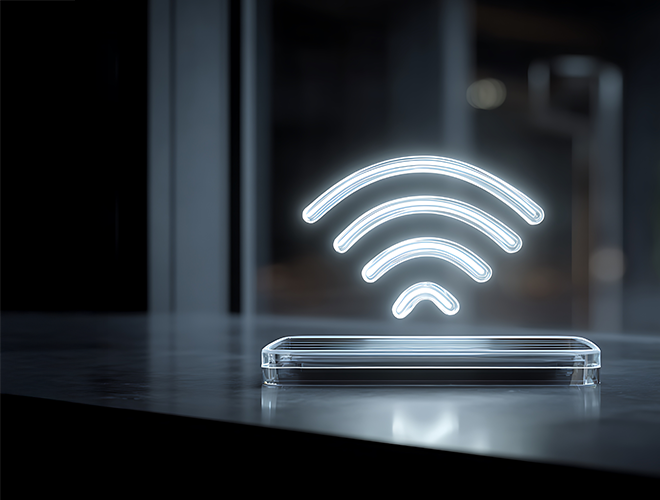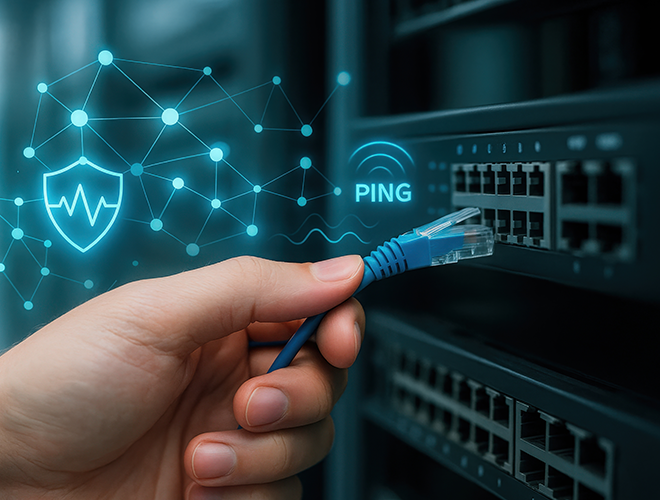Let us first understand what Wi-Fi is, and then dive into its advantages and different types of Wi-Fi connections.
What is Wi-Fi?
Wi-Fi is a wireless networking technology that allows devices such as computers, mobile phones, and other equipment to interface with the internet without the need for cables. The technology uses radio waves to provide high-speed networks and Internet connections.
The wireless part of the network is often called a WLAN (Wireless Local Area Network). Because a Wi-Fi network uses the unlicensed 2.4 GHz and 5 GHz frequency ranges, it does not interfere with other neighboring wireless networks using those frequencies (or bandwidths).
Full form of Wi-Fi
A common misconception about Wi-Fi is that it stands for ‘Wireless Fidelity. In actuality, there is no full form of Wi-Fi. It does not stand for anything!
To come up with a catchy name for a newly developed wireless technology that had previously been known as ‘IEEE 802.11b Direct Sequence’, the term ‘Wi-Fi’ was created. But how did it come into being? Let’s understand.
Wi-Fi: The Origin Story
Hedy Lamarr and George Antheil's invention of radio frequency jumping technology was a vital step in the development of Wi-Fi.
A crucial patent used in Wi-Fi was created by the Australian radio astronomer John O'Sullivan together with his colleagues Terence Percival, Graham Daniels, Diet Ostry, and John Deane as a byproduct of a Commonwealth Scientific and Industrial Research Organization (CSIRO) research effort, ‘A failed experiment to detect erupting small black holes the size of an atomic particle.’
The first step in network attachment was the 802.11 protocol, where a device was required to establish its identity with a router or AP (Access Point). The 802.11 protocol's initial introduction in 1997 offered link rates of up to 2 Mbit/s. The 802.11b update, which allowed for 11 Mbit/s link speeds, was made in 1999 and quickly gained popularity. Since then, we have come a long way from 11 Mbps to now 2.4 Gbps.
How does Wi-fi work?
Contrary to what people might think, Wi-Fi is not the internet but uses the internet through a wireless router. Wi-Fi connection uses radio waves to transmit information between your device and a router via frequencies.
A Wi-Fi network broadcasts data among a network. To transform data into radio signals, it needs a wireless adaptor. The router, which decodes the signals, receives the signals through an antenna. The signal is then delivered to the Internet over a connected ethernet connection after being decoded by the router.
Apparently, one router can be used to connect multiple devices to the internet as long as they all have wireless adapters. This connection is handy, virtually undetectable, and generally dependable. Still, users risk interference or losing connections if the router malfunctions or if too many people attempt to use high-bandwidth applications simultaneously.
Types of Wi-Fi Connection
As technology advances, different types of wireless networks have been introduced, which can be set up at their homes, offices, schools, etc. The number of wireless connection alternatives you have at home is expanding as mobile networks penetrate the world of residential internet.
1. Wi-Fi router
Today, a wireless router is used in the majority of homes and offices to access the internet. The ease of setup, mobility within the router's (wireless access point) coverage area, and the capacity to connect multiple devices are a few of the benefits. The drawbacks include a constrained bandwidth, slowed speed as more devices join the same WiFi network, and possible interference from other electromagnetic devices in the house.
2. 4G LTE home internet
4G LTE Home Internet is beneficial to your use if you reside in a remote area with few options for internet access. It provides high-speed internet access delivered over cell phone towers and mobile networks, typically with less latency and more data than you receive via satellite. With average download speeds of about 25 Mbps which depends on your carrier, 4G LTE offers better speeds & dependability. Limited availability and high setup and service costs are a few drawbacks of 4G LTE home internet.
3. Mobile hotspot or a Jackpot
You might have had the chance to use a mobile hotspot when your mobile data pack must have expired when you were on the go.
Your phone and a jetpack are two typical hotspot gadgets. Today, almost any smartphone or tablet can be temporarily used as a hotspot, which makes it a perfect alternative if you occasionally require one. It is simple to use and does not call for the purchase of additional equipment, but it can quickly drain your data and battery life.
However, a jetpack functions as a special mobile hotspot that, like a smartphone, can pick up a signal from nearby cell towers. It supports more connections and has a wider Wi-Fi coverage area. Additionally, since it is a separate device, your smartphone's battery power remains unaffected.
4. 5G home internet
5G Home Internet (fixed wireless access) has the potential to develop into one of the best and most affordable internet services available when it becomes more generally accessible. It provides a larger capacity than 4G, much quicker speeds, and lower latency than most people experience at home using a new spectrum of potent radio frequencies across a wireless network.
Service reliability is frequently astounding because 5G wireless base stations are typically placed less than 10 miles from residential areas. The current availability of 5G Home Internet is the only true limitation, but things will change.
Advantages of using Wi-Fi
Wi-Fi comes with its own sets of advantages over a fixed-line. Let’s understand these.
1. Wi-Fi is more convenient than wired networks
Multiple people can join a wireless network at the same time. Through the router or a hotspot technology, connections can be established in a matter of seconds without any setup.
Within a few minutes, you can connect any device- your phone or laptop to your WI-Fi Network without the help of any professional. The wired networks do not have this usability and convenience. It takes longer to set up a wired network and give many users access.
2. Wi-Fi is easy to install
Installing wireless networks is simpler and less expensive, especially in historic or rental properties where the landlord forbids the installation of cables. Sometimes, it might just take a few minutes before you start using the network.
3. Wi-Fi is easily accessible
With WiFi, especially on mobile devices, you may complete your normal tasks from any location as long as you are within range of a Wifi Access Point. Internet access does not always require you to be seated directly in front of a computer. These tasks include sending emails, doing bank transactions, and reviewing work reports.
Limitations of Wi-Fi
Wi-Fi also comes with its share of limitations, which are:
-
The range is constrained as the farther away you go from the Wi-Fi router, the weaker its signal gets.
-
Interference from other devices, such as telephones and microwave ovens, and all other types of electromagnetic devices which can act as jammers to the Wi-Fi signal.
-
Power usage is substantial (Costs are not substantial, need to update this)
-
A data breach can often occur if the router is not secured with virtual firewalls or data is unencrypted.
-
The speed of the internet decreases as the number of users increases as it has limited bandwidth.
Bottomline
With the rapid explosion of mobile devices and mobility while accessing the internet, Wi-fi has become an inescapable network connectivity option. Network connectivity from your wireless network provider is also an option, but the costs of operating that is much higher than broadband.
Popular Searches
Managed WiFi Services | Managed Internet Services | Managed WiFi Solution For Businesses | Securing Your Wi-Fi Network | Managed Wi-Fi Services vs. Traditional Networks | Managed Wi-Fi on Campus | Managed WiFi Guide | Importance of Managed WiFi Services | Managed WiFi Solution Work for Business
















